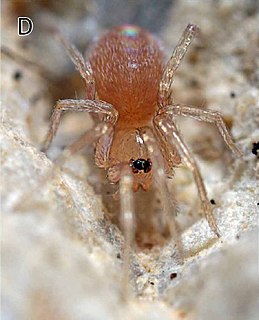Shelob is a fictional demon in the form of a giant spider from J. R. R. Tolkien's The Lord of the Rings. Her lair lies in Cirith Ungol leading into Mordor. The creature Gollum deliberately leads the Hobbit protagonist Frodo there in hopes of recovering the One Ring by letting Shelob attack Frodo. The plan is foiled when Samwise Gamgee temporarily blinds Shelob with the Phial of Galadriel, and then severely wounds her with Frodo's Elvish sword, Sting.

Oonopidae, also known as goblin spiders, is a family of spiders consisting of over 1,600 described species in about 113 genera worldwide, with total species diversity estimated at 2000 to 2500 species. The type genus of the family is OonopsKeyserling, 1835.

Linyphiidae, spiders commonly known as sheet weavers, or money spiders is a family of very small spiders comprising 4706 described species in 620 genera worldwide. This makes Linyphiidae the second largest family of spiders after the Salticidae. The family is poorly understood due to their small body size and wide distribution, new genera and species are still being discovered throughout the world. The newest such genus is Himalafurca from Nepal, formally described in April 2021 by Tanasevitch. Since it is so difficult to identify such tiny spiders, there are regular changes in taxonomy as species are combined or divided.

Theridiosoma is a genus of ray spiders that was first described by Octavius Pickard-Cambridge in 1879.

Periegops is a genus of spiders with six eyes instead of the usual eight. It is the only genus in its family (Periegopidae) and has three described species. It was long considered to be members of Sicariidae or Segestriidae until Raymond Forster elevated them to the family level in 1995.
Sinopimoa is a monotypic genus of Chinese sheet weavers containing the single species, Sinopimoa bicolor. It was first described by S. Q. Li & J. Wunderlich in 2008, and is found in China. It was originally placed in its own family (Sinopimoidae) but is now considered a member of the Linyphiidae, and it may be a member of the Erigoninae.

Agyneta is a genus of dwarf spiders that was first described by J. E. Hull in 1911.
Tennesseellum is a genus of sheet weavers that was first described by Alexander Ivanovitch Petrunkevitch in 1925. As of May 2019 it contains only two species, both found in North America, the United States, and on the Marshall Islands: T. formica and T. gollum.
Tennesseellum formica is a spider in the family Linyphiidae. It is found in North America and the Marshall Islands.

Ochyrocera is a genus of midget ground weavers that was first described by Eugène Louis Simon in 1892.

Dicymbium is a genus of dwarf spiders that was first described by Anton Menge in 1868.
Epiceraticelus is a genus of North American dwarf spiders containing two species: Epiceraticelus fluvialis and Epiceraticelus mandyae. The first described species in the genus, E. fluvialis, was first described by C. R. Crosby & S. C. Bishop in 1931, and has only been found in the Midwestern and Eastern United States. The second species, E. mandyae, was described in 2019 by M. L. Draney et al. and occurs in the Southeastern United States from Eastern New Jersey south to Georgia and west to Louisiana. The male of E. mandyae has a curved proboscis that extends from below the eyes. Epiceraticelus mandyae was named after the late arachnologist, Amanda Howe, in honor of her contributions to the North American arachnology community.
Esophyllas is a genus of North American dwarf spiders that was first described by T. R. Prentice & R. A. Redak in 2012. As of May 2019 it contains only two species, both found in the United States: E. synankylis and E. vetteri.
{{Automatic taxobox | taxon = Frederickus | authority = Paquin, Dupérré, Buckle & Crawford, 2008 | type_species = F. coylei | type_species_authority = Paquin, Dupérré, Buckle & Crawford, 2008 | subdivision_ranks = Species | subdivision = {{Specieslist | F. coylei|Paquin, Dupérré, Buckle & Crawford, 2008 – USA, Canada | F. wilburi|([[Herbert Walter Levi|Levi]] & [[Herbert Walter Levi|Levi]], 1955) – USA, Canada}} }}
Oaphantes is a genus of North American dwarf spiders that was first described by Ralph Vary Chamberlin & Vaine Wilton Ivie in 1943.
Oreonetides is a genus of dwarf spiders that was first described by Embrik Strand in 1901.
Oryphantes is a genus of dwarf spiders that was first described by J. E. Hull in 1932.
Tapinotorquis is a monotypic genus of North American sheet weavers containing the single species, Tapinotorquis yamaskensis. It was first described by N. Dupérré & P. Paquin in 2007, and has only been found in Canada and the United States.

Ogulnius is a genus of ray spiders that was first described by Octavius Pickard-Cambridge in 1882.
Notolinga is a monotypic genus of South American sheet weavers containing the single species, Notolinga fuegiana. It is a replacement name for Linga, already in use by a genus of molluscs. Eugène Simon described the first female in 1902 under the name "Neriene fuegiana", but the first male was not described until 2019. It has only been found in Argentina and on the Falkland Islands.







